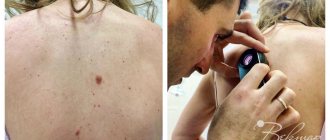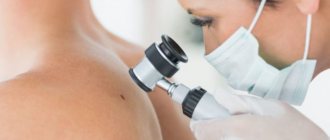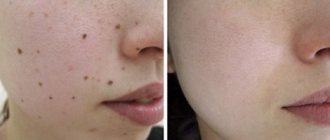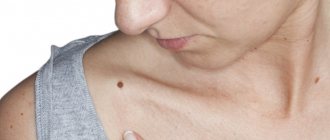Moles are a diagnosis that patients make for themselves. In medicine, there is a group of benign skin tumors with appropriate names, which are identified by doctors when patients come to them with “moles.” Most often, nevi of various varieties, angiomas (red moles), seborrheic keratosis, and dermatofibromas are detected. Much less often, melanoma or skin cancer is hidden under the guise of a “mole.” Before removing a mole with a laser, it is necessary to clearly determine the diagnosis. Sometimes, this requires dermatoscopy, scraping or even a biopsy.
Features of the procedure
Laser mole removal is most often performed under local anesthesia with lidocaine or another medication injected into the skin under the mole. Small seborrheic keratoses or red moles do not need to be anesthetized. If there are not very many moles or they are all small in size, then you can remove them with a laser in one session. It is necessary to limit the dose of the administered local anesthetic in accordance with the instructions due to the possibility of side effects. If pain medication limits are reached, removal of remaining moles is postponed to the next session. The healing speed of moles after laser removal varies greatly depending on the size, location, and depth. It ranges from several days to a month. Moles on the face heal the fastest. Slowest on your feet.
You should make an appointment for laser mole removal in advance so that you can prepare the device and schedule time for the procedure.
How they appear
Moles are divided into congenital and acquired.
Congenital nevi
This species represents a defect of embryonic development. Because of it, the transition of melanoblast cells into the skin is disrupted. Nevi appear due to the accumulation of these cells.
Moles appear in the first years of a person’s life.
Small-diameter nevi almost never degenerate. In larger ones, this process is most likely, so if there are such nevi, you need to be constantly monitored by specialists. It is forbidden to irradiate these nevi under ultraviolet light, and, if possible, it is better to remove them in a timely manner.
Acquired nevi
Nevi form in new places on the skin, changing contours, relief, and color. It is necessary to monitor these processes and have follow-up examinations with a doctor.
The appearance of moles can be genetic and can be passed on from parents to children.
Often moles begin to appear due to changes in the endocrine system associated with pregnancy or teenage changes. Also, the number of moles increases due to excessive exposure of the skin to sunlight, so excessive exposure to solariums and sunbathing negatively affects health.
By adolescence, the number of nevi increases, but by old age it decreases.
How much does laser mole removal cost?
| Consultation with a dermatologist on the day of mole removal using a dermatoscope up to 2 units. | 1200 RUR Sign up |
| Laser removal of single moles up to 5 mm, for 1 unit. | 1800 RUR Sign up |
| Laser removal of single moles over 5 mm, for 1 unit. | 2600 RUR Sign up |
| Laser removal of moles up to 3 mm, including consultation with a dermatologist, dermatoscopy and anesthesia, 3-6 pcs. | 2800 RUR Sign up |
| Laser removal of moles up to 3 mm, including consultation with a dermatologist, dermatoscopy and anesthesia, 7-12 pcs. | 3200 RUR Sign up |
Show all prices
Recovery period
Best materials of the month
- Coronaviruses: SARS-CoV-2 (COVID-19)
- Antibiotics for the prevention and treatment of COVID-19: how effective are they?
- The most common "office" diseases
- Does vodka kill coronavirus?
- How to stay alive on our roads?
After laser exposure, a dark crust forms at the site of the mole. This is a normal skin reaction to intervention. The crust forms a kind of protective layer that blocks damage/infection of the epidermis and helps to quickly return to normal. The main thing is not to tear off the crust, as an unaesthetic scar may form in its place.
The area should not be wetted for the first 5-7 days, but this does not negate general body hygiene. Try to protect your skin from mechanical damage, contact with cosmetics and ultraviolet rays. All these factors can slow down the recovery process and damage the structure of the skin. Treat the wound daily and lubricate it with medications prescribed by the dermatologist. After applying medications, you should use sunscreen or a spray that will prevent ultraviolet radiation from affecting the health of your skin.
Applying bandages or burning the surface with alcohol is also prohibited. If the condition of the wound bothers you (pain, redness, rash), be sure to inform your dermatologist.
Preparation and process
Before laser removal, it is advisable to get enough sleep and, if necessary, take a sedative in the evening. It would be a good idea to get rid of the hair around the mole using depilatory cream or carefully shave the hair.
Description of the process During removal by laser beams, evaporation (vaporization) of the tissues of the mole itself occurs, and then the pigment cells at its base (if it is a nevus). The depth of laser exposure and power will vary depending on the type of mole; it is determined by the doctor.
What to do after removal After laser removal of a mole, your doctor may prescribe ointments or medications to care for the wound. These could be drugs to speed up wound healing, antibiotics to prevent infections, or drugs to improve the appearance of existing scars. The doctor also determines whether or not to wet mole wounds.
Removing birthmarks and port-wine stains
Laser removal of birthmarks and port-wine stains is a very effective and popular procedure today. In the distant past, birthmarks on the human body were called nothing less than the “seal of Satan.” Today the attitude towards these entities is not so strict. And they are not credited with mystical or any other secret properties. Almost all people have such spots, regardless of skin color and race. For some people they are small and do not cause any discomfort. And in others they grow to impressive sizes and can cause discomfort. For some they give a special charm, while others simply get used to them. But vascular nevi are not as harmless as they seem. Know that there is always a risk that a birthmark may one day turn into a malignant tumor.
Indications for removal:
- Injured regularly (hair removal, razor),
- friction (belt, collar, straps).
- Degeneration (change in color or shape, appearance of scales, bleeding, increase in size, pain).
It is important to know that you absolutely cannot touch, much less remove, any nevi yourself. A safe, innovative and very effective method is laser birthmark removal.
Advantages:
- Small vessels become thrombosed.
- Bloodlessness of the operation.
- The surrounding tissues are not injured.
- The possibility of metastases is excluded,
- No traces are left.
- Painless.
- No contact with tools.
- Fast recovery period.
The only drawback is that this method does not allow us to conduct a histological examination. Therefore, it must be done in a medical facility.
Removing birthmarks and port-wine stains
Removing birthmarks and port-wine stains
Contraindications:
- Pregnancy and lactation.
- Taking medications that increase sensitivity to light.
How is the procedure done?
If necessary, anesthesia is performed. Then the skin is disinfected and the birthmark is burned out with a laser. During the session, a slight burning sensation is allowed. A depression may remain at the site of the procedure, which will become equal to the surface of the skin in fourteen days. The duration of the session is no more than five minutes, and the rehabilitation period is only two weeks. After healing and renewal of the skin, no traces are noticeable at the site of the birthmark. Care after removal. It is very important to listen to your doctor's recommendations. To take adequate care of your skin after removing birthmarks.
To obtain a stable and sustainable result. The crust that forms must be protected from any influence (gels, water and creams). You cannot remove it by force; this can stop the process of growth of the epidermis and lead to scars. After the crust is peeled away, tender skin remains in its place. Which also needs to be protected from mechanical, thermal and ultraviolet influence.
Healing
You need to take care of the treated area until then. Until the skin on it becomes the same color as the skin around it. Effective and popular procedure, impressive size birthmark, vascular nevi
Call us for a free consultation about skin or injections. By phone +7 985 233 0025.
Or visit our cosmetic skin clinic to learn more!
Why are moles dangerous?
Moles such as pigmented nevi can turn into melanoma over time. Sometimes they grow in width for many years and are not bothered by anything else. However, as soon as nodular melanoma forms, the mole becomes convex, begins to bleed, or even metastasizes throughout the body. Nodular melanoma is a very common cause of death. Melanoma itself is not removed by laser. However, many nevi, possible precursors of melanoma, can be removed with laser. Skin cancers (basal cell and squamous cell) can form from moles such as seborrheic keratoses or nevi without pigment cells. Skin cancer is not as dangerous as melanoma. But people often die from it too. It's easier to remove moles with a laser without waiting for them to turn into something more dangerous.
Sign up for a consultation
In what cases is it necessary to remove a mole?
Surgery is necessary if a mole is damaged frequently. If the formation is located on the scalp, chin, neck, groin, back or folds of skin, it constantly comes into contact with clothing/accessories, which leads to injury. Moles on “pedicles” should also be removed to avoid twisting or tearing off the stem.
Another common reason for removal is aesthetic. Volumetric nevi on the body or face make adjustments to a person’s appearance. Some people consider this their highlight, others try to hide the age spot by any means. Laser excision or vaporization is perfect for this.
For aesthetic purposes, a mole can not only be removed, but also created. This is possible with the help of tattooing.
The only caveat is that it will not be possible to remove the tattoo without a trace, so the mole will remain with the person for life.
Laser removal equipment
There are several classes of laser devices for removing moles. The most commonly used is a diode laser. Beams of light with the required wavelength are formed inside the device, and from there they travel through a light guide to the mole. The wavelength of the laser light is selected so that it is primarily absorbed by water or blood, that is, it heats them up very quickly. Rapid heating by the laser causes instant evaporation of water from the mole and does not heat up the skin around it or the fatty tissue underneath it. The less healthy tissue heats up, the faster the wound heals and the fewer scars.
What you need to know about laser surgery?
Laser surgery is one of the methods of performing surgical procedures. It involves removing/cauterizing small areas on the human body. The advantage of the method is minimal damage to surrounding healthy tissue and rapid restoration of the epidermis. For different types of operations, a specific type and power of equipment is used.
Laser surgery is used to correct vision, remove tumors, remove blockages in arteries, and excise pigmented formations.
Is it safe to remove moles?
Today you can often see offers to remove moles using the laser method in a cosmetology office. For safety reasons, this is absolutely not worth doing. To carry out high-quality nevus removal, you should contact specialized medical institutions, where the procedure is performed by experienced medical workers. It is possible to immediately send the material for histological examination. Beauty salons do not provide this service. If a mole is suspected of being oncological, it is not recommended to use the laser method, which does not allow taking a tissue sample.
If the technology is followed, the nevus removal procedure is absolutely safe. The laser acts locally only on tumors, without heating neighboring organs and tissues.
Possible consequences of the operation
Sometimes the healing process occurs with various deviations from the norm, which can occur regardless of how carefully the preventive requirements are followed. This may include the following:
- Nevus recurrence (re-formation of a mole). This situation is possible if during the operation the mole was not completely removed, and a small amount of nevus particles remained on the skin. Gradually, the cellular tissue grows, and the mole forms again. This does not pose a health risk, but in the future you will have to undergo the removal procedure again.
- Hypopigmentation is the formation of a white spot at the site of removal. This cosmetic defect occurs after removal of a deep-lying tumor. Hypopigmentation also occurs when exposed to sunlight. A white spot on the skin usually goes away on its own, but it takes at least a year.
- A hypotrophic scar is a scar at the site of a removed mole, the cause of which is the low rate of tissue restoration. This is usually a shallow defect, and over time the scar tissue smoothes out on its own.
- A hypertrophic scar is a small bump at the site of a removed mole, usually darker in color than the surrounding skin. The defect may go away on its own, or the doctor will prescribe additional cosmetic procedures that smooth the skin.









